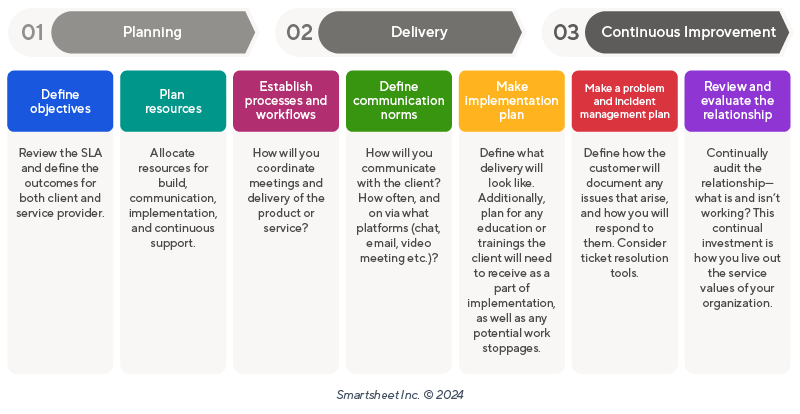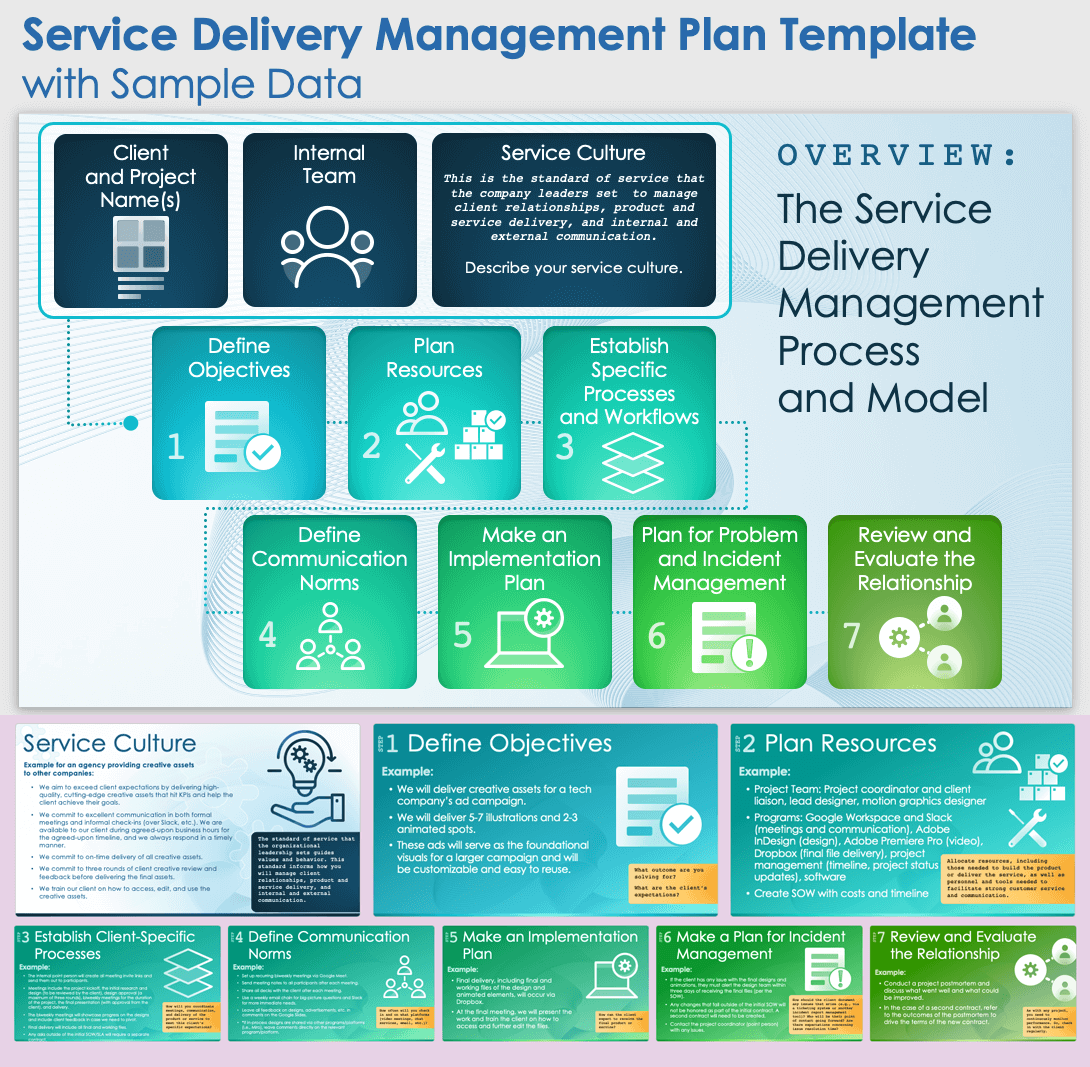What Is Service Delivery Management (SDM)?
Service delivery management (SDM) is the process of overseeing and coordinating the delivery of services to customers. The goal of SDM is to consistently meet customer expectations in terms of timeline, cost, quality, and performance.
SDM is a more formal extension of strong client management, which shares the goal of delivering consistently on client expectations. To learn more about providing top-notch customer service, see this comprehensive guide to field service management and this article on the basics of client management.

Chris Estrada, Founder and CEO of Nationwide United Auto Transport, integrates SDM into his leadership. “Service delivery management orchestrates the seamless execution and delivery of services, ensuring customer satisfaction and operational efficiency,” he says. “Unlike IT project management, which focuses on specific tech projects, service delivery management encompasses a broader scope, including ongoing service performance and quality assurance.”
SDM is a critical pillar of operational excellence. Learn more in this guide to operational excellence.
It’s important to note that service delivery management can also apply to IT-specific projects. Often referred to as information technology service management (ITSM), this approach aims to ensure that clients have the necessary resources to operate IT services — whether software, hardware, or network-related — with minimal help from technical specialists.
In IT projects, SDM involves managing communication channels between IT teams and the client. Challenges frequently arise when the client lacks IT experience or confidence with the technology, and therefore can’t fix technical issues on their own. Given the critical role of IT systems in the day-to-day activities of any organization, maintaining strong and reliable communication is crucial.

Arjun Naik is a technical lead at First Citizens Bank and has ample experience with service delivery management in IT settings. He says, “Service delivery management is a technique-oriented method to manage the transport of offerings to clients. It focuses on making sure that IT offerings meet the agreed-upon carrier degrees, first-class standards, and business requirements at the same time as maximizing purchaser pleasure.
"This article will mainly focus on non-IT SDM. To learn more about ITSM, see this guide to the IT infrastructure library (ITIL) framework.
Main Components of Service Delivery Management
The four key components of service delivery management are service culture, employee engagement, service quality, and customer service. While sales and support staff interact with customers the most, service values must be upheld across every department in the organization.
Here is more information about each of the four components:
- Service Culture: Service culture refers to the standard of service set by company executives that guides values and behaviors within an organization. The service culture informs how teams manage client relationships, product and service delivery, and internal and external communication.
Remember: Just because management doesn’t directly interact with the customer doesn’t mean they are exempt from the company’s service culture values.
- Employee Engagement: Employee engagement refers to the level of commitment and enthusiasm with which employees uphold the service culture of the company. Human resources and middle management are responsible for modeling the values defined by upper management to increase employee engagement.
- Service Quality: Service quality involves defining the strategies and processes that teams will use to deliver value to the client. This means setting standards for communication, company representation, delivery methods, ongoing support, and more. In effect, this step is the foundation of the customer experience, as it directly influences what the customer interacts with.
- Customer Service: Customer service includes all client-facing communication, materials, and delivery of products or services. This component focuses on providing clients with the expected value and equipping them with the education or additional materials needed to get the most out of the service. As an ongoing component of SDM, customer service includes general account management, continuous improvement, and activities such as service testing, issue resolution, upgrades, or retirement of services.
SDM for IT projects includes similar components, but they are more technical and specialized. The main components for IT project service delivery include service desk management, incident management, availability management, capacity management, reporting and review, IT systems financial management, and IT continuity management.
Service Delivery Management Model and Framework
It’s important to define a service delivery model or framework so that your customers can expect the same, top-notch service in every engagement. Doing so improves client relationships and customer retention, while saving you time and money since you don’t have to reinvent the wheel with every new customer or service engagement.
When setting up your SDM framework, always look at it from the client’s perspective. This ensures that you build a model that serves the client’s desired outcome, not just your operational efficiency.
Service Delivery Management Process
The service delivery management process includes defining objectives, planning resources and workflows, setting communication norms, developing an implementation plan, and holding relationship evaluations. An effective process addresses all four components of SDM.
Below are the steps in the SDM process:
Define Objectives: What outcome are you solving for? What are the client’s expectations? You can find these answers in your service-level agreement (SLA) and your project plan. A strong project plan will clearly define objectives, scope of work, service delivery processes, and roles and responsibilities. You should also include key performance indicators (KPIs) so that all parties agree on the metrics of success.
Together, your SLA and the project plan outline your contractual obligations in terms of timeline, cost, quality, and performance specifications.
- Plan Resources: Once you define your deliverables, it’s time to allocate resources. This includes any resources needed to build the product or deliver the service, as well as personnel and tools needed to facilitate strong customer service and communication.
- Establish Specific Processes and Workflows for Each Client: Part of the SDM process requires defining subprocesses that you will follow for each particular client. How will you coordinate meetings, communication, and delivery of the product or service to the client to meet their specific expectations?
- Define Communication Norms: Each client is different, and it’s up to you to define communication standards that meet each customer’s needs. How often will you check in and on what platforms (video meetings, chat services, email, etc.)? Part of strong service delivery management is transparent communication throughout the course of the relationship. Keep clients informed of any delays or issues that arise, and get their signoff before proceeding in new directions.
- Make an Implementation Plan: In this step, define what delivery will look like. How can the client expect to receive the final product or service? Consider any work interruptions, and communicate expectations with the client. Also consider any education the customer might need at the time of service delivery, and set aside time to train them on how to use, monitor, and seek assistance for the new service.
- Make a Plan for Problem and Incident Management: Define how you and the customer will manage any issues that arise with your product or service. How will they document the issue (e.g., using a ticketing system or other incident report management tool)? Who will be their point of contact going forward? Are there expectations on issue resolution time? This is a huge piece of customer service, so you should plan it early in the process.
- Review and Evaluate the Relationship: As with any project, you need to continuously monitor performance. In this case, performance refers to both the quality of the product or service and the client relationship itself. Check in with the client regularly. This might be as casual as requesting impromptu feedback or as formal as an audit of your SLA.
Remember: The best way to improve client retention is to live out the service culture defined by your executives and continually re-invest in relationships.

Free Service Delivery Management Plan Template

Download a Service Delivery Management Plan Template With Sample Data for
Microsoft PowerPoint | Google Slides
Download a Blank Service Delivery Management Plan Template for
Microsoft PowerPoint
| Google Slides
Use this free template to guide your SDM process. It includes fields for each essential process of your plan, as described above. Additionally, there is space to document the service culture, ensuring that your plan embodies your organization’s values. We’ve included a template with sample data — for an ad agency providing creative assets to a tech company, which you can use as a guide for your own SDM planning. There is also a blank version for you to write your plan from scratch.
Service Delivery Management Best Practices
Effective service delivery management is essentially strong relationship management. SDM best practices include listening to your customers, setting clear expectations, communicating effectively, and continually monitoring performance. By doing so, you can ensure consistent delivery of high-quality services.
Here are some key service delivery management best practices:
- Create a Clear SLA: At the outset of the new client relationship, create a service-level agreement (SLA). By doing so, you ensure that all parties are on the same page and you set clear expectations concerning quality, performance, timeline, and budget. You can refer back to the SLA upon delivery to ensure that all parties fulfilled their responsibilities and are satisfied with the results.
- Maintain Strong Communication: Communication is a central tenet of SDM and overall customer experience. Define communication norms, and regularly meet with your customer to address concerns, share updates, and maintain a strong personal connection.
- Overestimate Resources: In your SLA, overestimate the resources you’ll need to complete the job. It’s better to build in a buffer in the initial contract than to end up going over schedule and budget, which risks additional project delays and might weaken your relationship with the client.
- Get Feedback From Your Client: Seek direct feedback on your communication, quality of service, and deliverable quality from your client. If possible, hold a formal evaluation or project post-mortem, and discuss what went well and what could have gone better.
- Remain Flexible: Don’t become too rigid in your processes. Remain flexible so that you can meet the client’s needs in terms of communication, processes, timeline, and exact deliverables.
Estrada says that many teams overlook the importance of adaptability and flexibility when defining their plan. “This can lead to missed opportunities for optimization,” he explains. “Establish transparent communication channels, continuously monitor and adjust your service delivery to meet customer expectations, and leverage feedback for improvement.”
Service Delivery Management Examples
Service delivery management is an aspect of any client-service provider relationship. Examples of SDM projects include SaaS services, employee onboarding, and legal services. The most common industries that use SDM include legal services, consulting, accounting, marketing, and IT.
Here are some examples of service delivery management projects in the real world:
- Installing SaaS Products: Any software-as-a-service (SaaS) product — including project management software, collaboration tools, and communication tools such as chat and video meeting services — needs to be deployed effectively. In these scenarios, successful service delivery management ensures that the service provider deploys the SaaS tool on time, with the agreed-upon budget and specifications — such as number of users, capabilities, and premium add-ons. You are also responsible for any training or ongoing support the client might need to use the tool.
- Employee Onboarding: Service delivery management is an important part of internal processes too. When onboarding new employees, your organization should have a reliable process in place to acclimate newcomers to your company culture, tools, and key points of contact, in addition to training them for their specific role. In this case, the service in question is the onboarding experience and ongoing HR support, so make sure it lives up to your company’s values and standards.
- Legal Services: Companies and individuals contract with legal service providers for a number of services, including contract creation, document verification, and compliance audits. Organizations can seek legal services from law firms or alternative legal service providers (ALSPs), but note that ALSPs typically cannot represent clients in court proceedings.
- Accounting Services: While larger companies typically have in-house accounting departments, many small companies or individuals seek external accounting services for help with taxes, payroll, and other financial management tasks. As with legal services, it’s important to define the scope of work with an SLA upfront because the service is intangible (i.e., there won’t be a delivery of a physical product or tool).
- Health Services: Health service providers offer an array of health-related services, including appointment scheduling, connecting patients to medical providers, managing insurance compliance, and more. The relationship between patients and health service providers — such as medical professionals, insurance companies, and hospitals — is an ongoing, evolving partnership.
Service Delivery Management Case Study
Chris Townsend is a relocation specialist with Three Movers. He shares the following real-world case study from his experience coordinating cross-country moves.
“In our moving business at Three Movers, our unique case study involves a high-profile client move with tight timelines. By implementing agile SDM practices, including client collaboration and risk mitigation, we exceeded expectations,” he states. “Regarding specific project plans, the key lies in adaptability and meticulous planning.”
Benefits of Service Delivery Management
Service delivery management enhances operational efficiency, builds strong client relationships, increases customer retention, and improves the bottom line. The best way to attract more clients is to build a strong reputation with exceptional products, services, and customer service.
Here’s a bit more detail on the top benefits of instituting a strong SDM process:
- Improve Client Retention Rate: Clients are much more likely to continue working with tools when they feel supported in deployment, installation, and continual upgrades.
- Differentiate Your Brand Through Strong Customer Service: When clients have a great time working with you, your company’s reputation improves, which leads to new clients and more business. Client-facing work is a key place to prove your company’s stated values so that you can differentiate the company through quality work.
- Deliver New Systems Faster: When you have a reliable process for implementing and checking new services, you’ll reduce the time spent on each individual installation or system upgrade.
- Reduce Costs: Effective service delivery management allows you to do more with less. This means you’ll spend less money responding to one-off concerns.
- Ensure Smooth Technology Onboarding and Transition: Whether your IT team is responsible for onboarding your internal, non-technical teams or implementing new technology for clients, strong SDM will smooth out the entire process. In turn, this reduces time and cost spent answering questions or fixing issues that you could anticipate and solve for upfront.
- Inspire Confidence in Non-IT Teams: Strong SDM processes make it simple for non-technical team members to ask questions, report issues, and deal with IT directly. This can also reduce day-to-day reliance on the IT team to fix small problems.
Benefits of Using Service Delivery Management Tools
Several tools are available to help you streamline and elevate your service delivery management process. Tools range in capability depending on your needs — from simple project management tools to incident report management.
Here are some of the most common types of tools you can use in an SDM context:
- Customer Relationship Management (CRM) Software: You can use CRM tools to store, organize, and manage client contact information and other account details. By doing so, you can provide the highest-quality support and services for the duration of the relationship.
- Project Management Tools: You can also use PM software to manage customer relationships and track the history of services provided. Project management tools allow you to create detailed project plans so that all parties are on the same page. More sophisticated PM tools include capabilities to track incidents, monitor performance, and create dashboards and reports.
Learn more about how you can use Smartsheet, a collaborative work management platform, with these IT operations management tools
- Communication and Collaboration Tools: At the most basic level, make sure you have tools in place to quickly and effectively communicate with your clients or internal teams when issues arise. These could be instant messaging apps, video meeting tools, email, or other collaboration tools.
- Incident Report and Resolution Software: These tools allow you to capture, track, and report on any incident or issue that arises during the relationship, including system issues, delays, or even a poor customer service interaction. Then, you’ll have an accurate log of all incident report history.
- Performance Monitoring Software: This allows you to keep an eye on your system performance and, in some cases, respond to issues directly. These tools might include automatic alerts, tracing systems, and dashboards for easy reporting. Performance monitoring software is a general term, so make sure you select a tool that directly addresses your needs.
“In my experience, employing a specialized software such as an integrated service management tool greatly enhances control and visibility over all aspects of service delivery, from ticketing to performance analytics,” says Estrada. “It's vital to choose tools that offer scalability, user-friendliness, and comprehensive integration capabilities to support all service delivery facets.”
Townsend echoes this idea. “Prioritizing user-friendly platforms that enhance collaboration is crucial,” he says. “We've found success with software that integrates scheduling, communication, and tracking. In your search for SDM tools, consider scalability, user interface, and adaptability to your specific industry nuances. Remember, the human element remains paramount, as successful service delivery is ultimately about meeting clients' needs with efficiency and care.”
Additionally, make sure to choose user-friendly programs. This reduces the time and money spent training teams to use the tools and increases the chances that people will actually use them.
Learn more about these sophisticated service delivery solutions to help you standardize and automate workflows, optimize resources, and deliver value more quickly.
Use Smartsheet to Elevate Your Service Delivery Management Process
From simple task management and project planning to complex resource and portfolio management, Smartsheet helps you improve collaboration and increase work velocity -- empowering you to get more done.
The Smartsheet platform makes it easy to plan, capture, manage, and report on work from anywhere, helping your team be more effective and get more done. Report on key metrics and get real-time visibility into work as it happens with roll-up reports, dashboards, and automated workflows built to keep your team connected and informed.
When teams have clarity into the work getting done, there’s no telling how much more they can accomplish in the same amount of time. Try Smartsheet for free, today.